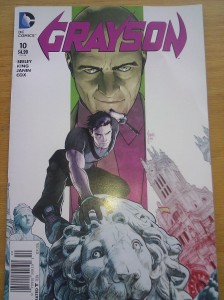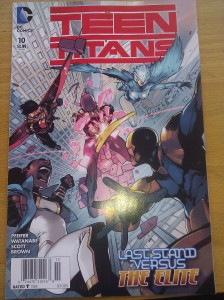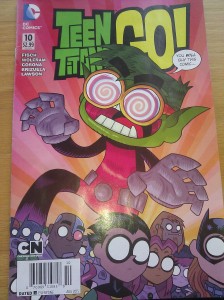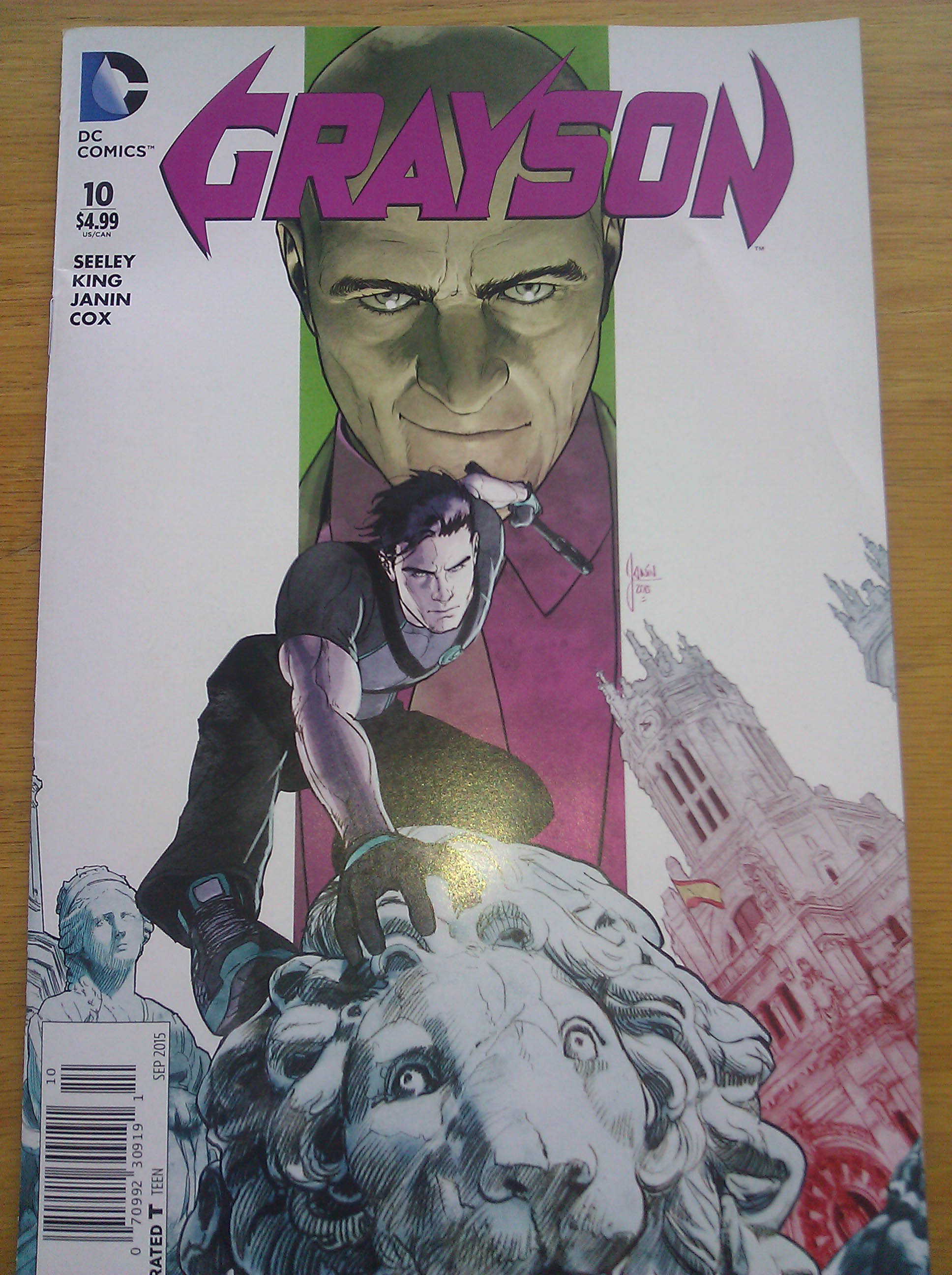With all the talk about comics prices, the number of $4.99 #1 issues in the Marvel relaunch and the general chaos over at DC right now, it might interest you to know that DC already has a line of $4.99 comics. If you didn’t know that, you probably weren’t looking in the right place. These aren’t the comics coming out through Diamond, they’re the returnable ones at the bookstore.
I’m not going to call this the newsstand line, since it isn’t clear that DC is actually on the traditional newsstand anymore. They pulled out of the ID wholesale system they’d previously been using, but are still in the comic sections of a few bookstores like Barnes & Noble and Books-A-Million. As near as I can tell, DC is offering somewhere in the neighborhood of 12 different titles from what used to be called “The New 52” and then some kids times for the bookstore racks. In general, things are $1 more expensive for this returnable edition. Let’s have a look at what was on the newsstand this last weekend.



And yes, that does mean when you had a double-sized issue of Justice League, that bumped up to an impressive $5.99.
It even seems, at least at the Books-A-Million I was visiting, that these comics were selling. That doesn’t bode well for holding the line at $3.99. After all, as my favorite Dan DiDio quote goes:
“The truth is people are leaving anyway, they’re just doing it quietly, and we have been papering it over with increased prices,” DiDio said. “We didn’t want to wake up one day and find we had a bunch of $20 books that 10,000 people are buying.”
We’ll see what the August sales estimates look like, and that’s when I’ll personally feel a little more comfortable discussing DC’s most recent relaunch, but it sure doesn’t look good based on the July estimates.
In a world where a lot of publishers like to price the first trade paperback in a series at $9.99, that’s essentially the same price point as two issues of Batman. Roughly 25 cents per page. Or to put it another way, you can read two or three pages of Superman or play a game of pinball. Personally, it takes me a lot longer to play a pinball game than it does to read two or three pages of a comic, but I supposed your mileage may vary.
I also find it very interesting that Teen Titans Go is holding the line at $2.99 and less expensive than anything else DC has at the bookstore. Could it be they just sell that many more kids comics or could it be that DC doesn’t think parents are likely to spend $5 for a 20 page comic and they can still afford to price it that way.
If you’d like to get a better understanding of how the Direct Market works and how digital comics plug into it, here’s a like to Todd Allen’s book on the industry: Economics of Digital Comics.









Todd, thanks for this article. Glad to see i’m not the only “fool concerned with price tag on comics”. :)
Interesting counterpoint to the doom and gloom people have been throwing at the #DCYOU relaunch:
http://graphicpolicy.com/2015/08/31/dc-comics-dcyou-shows-strength-looking-beyond-physical-sales/
The $1 increase is for NEWSTAND comics only. This is DC supporting the Direct Market which loses countless dollars year-to-year to the larger chain bookstores. And before jumping on DC’s case look at some history: MARVEL actually used the same gimmick a few years ago when they raised their prices $1 per book at the newstands (if memory serves it was sometime around 2011). This isn’t DC being greedy, it’s DC looking out for the little guy and offering a lower cover price for comic book store customers
Wow Erik, that’s a really interesting article. Thanks for sharing that link.
Honestly, Clint, it looks more to me like offsetting the cost of returnability. Which they have every right to do, especially if it allows them to get their comics into another market.
A cynical person might say that he happily pays the $1 per book surcharge just to stay out of the dark and dusty comic book shops. Okay, I’m just joking, RELAX!!!
Using Uncanny X-men as a baseline, here’s how the cover price would look in today’s dollars due to inflation.
1981 $.50 in 2015 would be $1.31
1982 $.60 in 2015 would be $1.48
1985 $.75 in 2015 would be $1.66
1988 $1.00 in 2015 would be $2.02
1992 $1.25 in 2015 would be $2.13
1994 $1.50 in 2015 would be $2.42
1995 $1.95 in 2015 would be $3.05
2001 $2.25 in 2015 would be $3.02
2004 $2.99 in 2015 would be $3.78
2010 $3.99 in 2015 would be $4.37
I’m sorry but anything over $3 a book is completely ridiculous. The only reason I don’t buy as many titles as I used to is price. I used to try everything, no matter the artist, no matter the writer, no matter the character or publisher, I’d give anything a try. Now I’m down to about 10 books a month and I’m about to give up with these prices. I’d rather go back to books printed on newsprint than keep paying these rates.
I pay $3.99 for the smaller publishers but that’s it for me. If Marvel and/or DC move to $4.99, there’s no way the little guy can’t follow suit and my 30+ years of buying new comics will come to an end.
Mike
Another explanation for the persistant $2.99 price for Teen Titans Go! would be that the TV show is a great support (and I live in France) to the paper version – or is it the other way round? One would have to have a closer look at the audience figures and floppy sales to confirm that – and as such, it complements Todd’s possible explanation that parents probably wouldn’t pay more than $2.99 per issue to support their childrens’ desire to pursue the Teen Titans adventures in comic book form as well. As a parent myself, I know that I wouldn’t.
Now, as an adult reader, I only buy two or three titles from the big two (because of the artists and writers working on it mainly) given their recent prices evolution. I don’t mind paying more if it’s to support smaller publishers – yet, I know the meaning of “smaller” should be put in perspective – as I sincerely think we have to support them since they regularly put on their A-game these last years.
Ànyway, very interesting article.
That quote from Dan Didio about raising prices on a shrinking audience is amazing. He’s absolutely right (in the quote), but in practice, most publishers are still “papering over” the reality of a shrinking audience with higher prices. Same thing in book publishing. We’re at a point now where you can easily spend $18 for a regular paperback novel.
This is a losing strategy for all the obvious reasons. Readers are the lifeblood of publishing and other small-item entertainment products, where you need lots of unit sales to make the economies of scale work. Loyal readers will sometimes pay a premium price for a premium product like IDW’s Artist Editions. But very few will pay an inflated price for the same product that was cheaper yesterday.
I’ve seen scenarios where a comic line commanded a premium price and turned into something lucrative with a small readership, but none of them have lasted. If you’re making things for a small audience, you need ALL of them to stay for the long haul, or else you lose too much margin, and that’s too difficult a trick to pull off.
I feel like the floppy business is winding down as more and more people who have been reading for 30 years are going to balk at the over inflated monthly price and new readers are not going to pay $3.99 for 20 pages in the digital age.
I am curious what the real digital strategy of the comic companies are since they have to know they can no sustain at this rate of decline vs. price increases before it kills the remaining base.
10¢ was the cover price for a comic in 1960. Allowing for inflation, that should be 81¢ today.
The reality is that comics just don’t have the accessibility they did then, and I’m not talking about where to buy them. The more comic sales have contracted over the last 40 years the more Marvel and DC have focused on their core audience. Continuity based titles, decompressed storytelling and multi-part cross-overs.
Comics only seems to be able to keep going because the independents seems to have a never ending supply of creators who will work for free to get into the industry. The creators get nothing, the publishers promote the work enough to cover their overhead and salaries but not pay royalties. Why should they if they don’t own it?
Jason and Dave really nailed it. We are approaching the end of an era, but that’s okay. I personally welcome the arrival/gain in popularity of non-floppy formats. Floppies are a bitch to store and don’t look good on a bookshelf. I’m personally all trades at this point, and I’m sure eventually even that will give way to digital.
I stopped buying floppies 15 years ago. All I’ve bought since then are trades, graphic novels and reprint volumes. As Zach says, floppies are “a bitch to store.” I’ve reduced mine to exactly one longbox, full of floppies that haven’t been reprinted in book form, and that I love too much to dispose of … for now.
Floppies are computer discs. What’s so shameful about calling them “comics” which is what they’ve always been called?
Try something next time you go out. Look at USA Today. Consider the amount of paper and ink they use. Consider their printing schedule. Then consider that they charge $1.50 per issue.
From what I’ve read, floppies are still the lifeblood of most comic shops. Without them, a lot shops would probably go out of business, especially the smaller ones that haven’t diversified their offerings. My days of weekly visits to comic shops are in the past, but I’d hate to see anyone lose their livelihood.
Trouble With Comics forum on “The Future of the Floppy”:
http://troublewithcomics.com/post/126317745911/twc-question-time-2-the-future-of-the-floppy
One writer says the people who are still buying monthly pamphlets are the now-middle-aged guys who were buying from spinner racks in the ’70s. (“Hey, Kids! Comics!”)
This is why I’m happy just getting Marvel Unlimited and wish DC had something similar. I don’t care about collecting anymore, I just want to read the books. For less than the price of two comics, I can read hundreds online
Amen.
Hey LB,
“Floppies are computer discs. What’s so shameful about calling them “comics” which is what they’ve always been called?”
I usually call them comics and very rarely say ‘floppies’ but I am guilty of thinking of them as such. Yet when you compare the thickness of a comic ten years ago to today, with the Marvel comics in particular, they seem to be printed on thinner paper than a Victoria’s Secret catalog. Most books are down from 32 pages plus covers to just 32 pages self covered and sometimes even 28 pages self covered for $3.99-$4.99.
They really do deserve to be called Floppies.
Comments are closed.